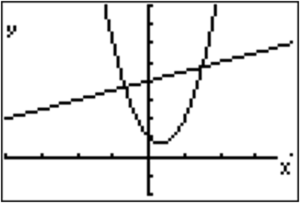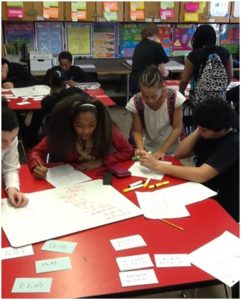 On Alex’s first day of Algebra class at his new school, the teacher projected a graph on the screen and asked the students to make a list of everything they notice about the graph. After an appropriate amount of time, she asked the students to stand up with their lists and find a partner. Once the students had all found partners, she asked them to alternate sharing the items on their lists, adding to and editing their lists as needed. She then had them find a different partner and repeat the process. After the second iteration, she had students return to their seats. The teacher then facilitated a whole class discussion about characteristics of the graph. She began by calling on a student to share one item from his/her list. Next, she asked another student if he/she had more to add on to the first student’s response. The process continued with the teacher speaking only to call on students, ask questions, and help clarify or move the conversation as needed. The activity ended with a student-generated list of all the characteristics that the teacher wanted to highlight plus a few others. The teacher didn’t just choose students at random in this process, but instead selected students while she was monitoring their individual work and pair share conversations. She also sequenced the responses so that the review progressed according to her plan allowing students to make connections through their own responses supported by questions from her. She learned this technique from NCTM’s book 5 Practices for Orchestrating Productive Classroom Discussions.
On Alex’s first day of Algebra class at his new school, the teacher projected a graph on the screen and asked the students to make a list of everything they notice about the graph. After an appropriate amount of time, she asked the students to stand up with their lists and find a partner. Once the students had all found partners, she asked them to alternate sharing the items on their lists, adding to and editing their lists as needed. She then had them find a different partner and repeat the process. After the second iteration, she had students return to their seats. The teacher then facilitated a whole class discussion about characteristics of the graph. She began by calling on a student to share one item from his/her list. Next, she asked another student if he/she had more to add on to the first student’s response. The process continued with the teacher speaking only to call on students, ask questions, and help clarify or move the conversation as needed. The activity ended with a student-generated list of all the characteristics that the teacher wanted to highlight plus a few others. The teacher didn’t just choose students at random in this process, but instead selected students while she was monitoring their individual work and pair share conversations. She also sequenced the responses so that the review progressed according to her plan allowing students to make connections through their own responses supported by questions from her. She learned this technique from NCTM’s book 5 Practices for Orchestrating Productive Classroom Discussions.
 Alex was quite surprised to be talking to other students and giving input in math class. This was a very different approach than what his previous math teacher used. In her class, she did all of the talking while students listened and took notes. Most days in that class Alex was bored and confused. He soon realized that this activity had allowed the teacher to find out what the students knew about graphs and provided an avenue for transitioning into the new learning by making connections to students’ previous knowledge. It also allowed him to review content and vocabulary before beginning the new learning, and best of all he enjoyed it. Alex’s teacher transformed the classroom routine of reviewing and accessing prior knowledge into a student-centered activity promoting intentional student to student discourse followed by whole group discussion. She knew the key to productive classroom discourse is giving students something to talk about and she did so by putting the review in the hands of the students rather than herself.
So, how do teachers develop lessons that promote discourse? One way is to transform daily classroom routines like bell ringers, homework revision, and lecture to intentionally include student discourse opportunities. Rather than the teacher “going over” the bell ringer or homework, design a structure for allowing students to do so. The Teaching Channel video, Student-to-Student Assessment, provides a discourse rich structure for allowing students to review and revise homework while supported by the teacher. A simple first step to implementing discourse is the use of a Think-Pair-Share strategy. During lecture, the teacher may present a question or statement for students to think about and then allow time for them to Pair-Share. The teacher can then orchestrate a whole group sharing of responses similar to the method used by Alex’s teacher. Besides creating their own, teachers can find high cognitive tasks that can be implemented using a pairing or group structure including student to student discourse at the Illustrative Mathematics, Inside Mathematics, and Implementing the Mathematical Practices websites.
Alex was quite surprised to be talking to other students and giving input in math class. This was a very different approach than what his previous math teacher used. In her class, she did all of the talking while students listened and took notes. Most days in that class Alex was bored and confused. He soon realized that this activity had allowed the teacher to find out what the students knew about graphs and provided an avenue for transitioning into the new learning by making connections to students’ previous knowledge. It also allowed him to review content and vocabulary before beginning the new learning, and best of all he enjoyed it. Alex’s teacher transformed the classroom routine of reviewing and accessing prior knowledge into a student-centered activity promoting intentional student to student discourse followed by whole group discussion. She knew the key to productive classroom discourse is giving students something to talk about and she did so by putting the review in the hands of the students rather than herself.
So, how do teachers develop lessons that promote discourse? One way is to transform daily classroom routines like bell ringers, homework revision, and lecture to intentionally include student discourse opportunities. Rather than the teacher “going over” the bell ringer or homework, design a structure for allowing students to do so. The Teaching Channel video, Student-to-Student Assessment, provides a discourse rich structure for allowing students to review and revise homework while supported by the teacher. A simple first step to implementing discourse is the use of a Think-Pair-Share strategy. During lecture, the teacher may present a question or statement for students to think about and then allow time for them to Pair-Share. The teacher can then orchestrate a whole group sharing of responses similar to the method used by Alex’s teacher. Besides creating their own, teachers can find high cognitive tasks that can be implemented using a pairing or group structure including student to student discourse at the Illustrative Mathematics, Inside Mathematics, and Implementing the Mathematical Practices websites.
 The shift to a classroom environment that promotes student voice is supported by Mathematics Practice Standard #3 Construct Viable Arguments and Critique the Reasoning of Others, the Danielson’s Framework for Teaching Domain 3B Using Questioning & Discussion Techniques, and 21st Century skills. A comparison of the Standards for Mathematical Practice, ELA Common Core Anchor Standards, and the Next Generation Science Standards Science and Engineering Practices (see Denise Finley’s blog, Intersecting Common Core Standards) shows that all three sets of standards include student discourse that requires students to think critically about their own thinking as well as that of their peers and produce appropriate arguments to support or refute reasoning. Besides addressing standards and practices, providing for student voice in the classroom engages students in constructing knowledge and enjoying mathematics.]]>
The shift to a classroom environment that promotes student voice is supported by Mathematics Practice Standard #3 Construct Viable Arguments and Critique the Reasoning of Others, the Danielson’s Framework for Teaching Domain 3B Using Questioning & Discussion Techniques, and 21st Century skills. A comparison of the Standards for Mathematical Practice, ELA Common Core Anchor Standards, and the Next Generation Science Standards Science and Engineering Practices (see Denise Finley’s blog, Intersecting Common Core Standards) shows that all three sets of standards include student discourse that requires students to think critically about their own thinking as well as that of their peers and produce appropriate arguments to support or refute reasoning. Besides addressing standards and practices, providing for student voice in the classroom engages students in constructing knowledge and enjoying mathematics.]]>
